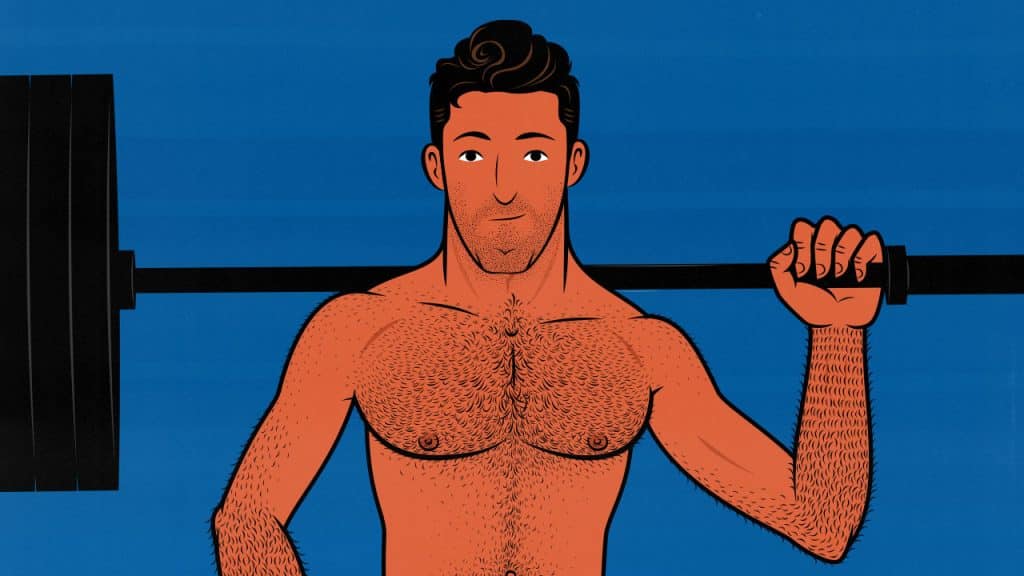
Can You Be Skinny and Strong? Yes, Kind Of
Some skinny guys with good strength genetics are stronger than they look. However, they would be even stronger if they built more muscle.
I’m a naturally skinny guy who was underweight into his twenties and then gradually gained 70 pounds. I’ve struggled to bench press an empty barbell. I’ve also benched 315 pounds. Gaining weight and building muscle is what made the biggest difference.
This is surprisingly controversial, and I see why, so let’s go deeper.
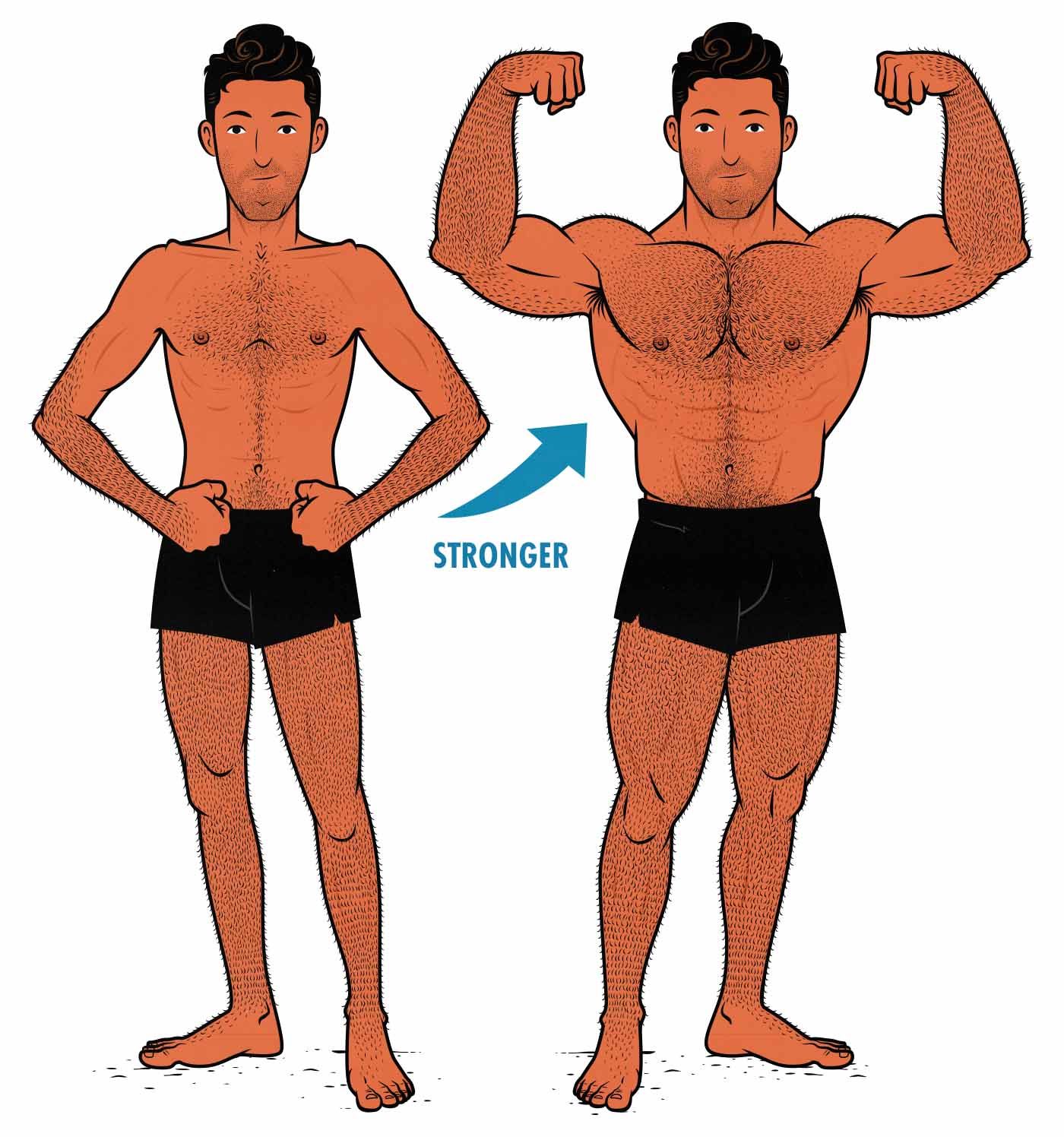
What is Strength?
You can define strength in a few different ways. If you ask a powerlifter, strength is how much you can barbell squat, bench press, and deadlift for a single repetition while using a lifting belt but not lifting straps.
Standards vary, but most guys are considered reasonably strong if they can bench press 225 pounds (2 plates), squat 315 pounds (3 plates), and deadlift 405 pounds (4 plates). To put that into context, that’s more than most lifters ever manage to lift, but it’s a reasonable lifetime goal for the average skinny guy. More on that here.
Powerlifting is the strength sport, so that’s where most strength standards come from. But if you ask a casual lifter, they might also care how much you can overhead press and barbell curl, or how many pull-ups and push-ups you can do.
Outside of the lifting community, strength is the ability to lift heavy things and perform physically demanding tasks without getting hurt. Someone who deadlifts more weight can usually carry the heavier fridge, but not always. Sometimes, they’re humbled by the skinny delivery man who practices carrying fridges all day, every day.
Strength Genetics
We all have different strength genetics. Here are two really good examples: body proportions and muscle insertions.
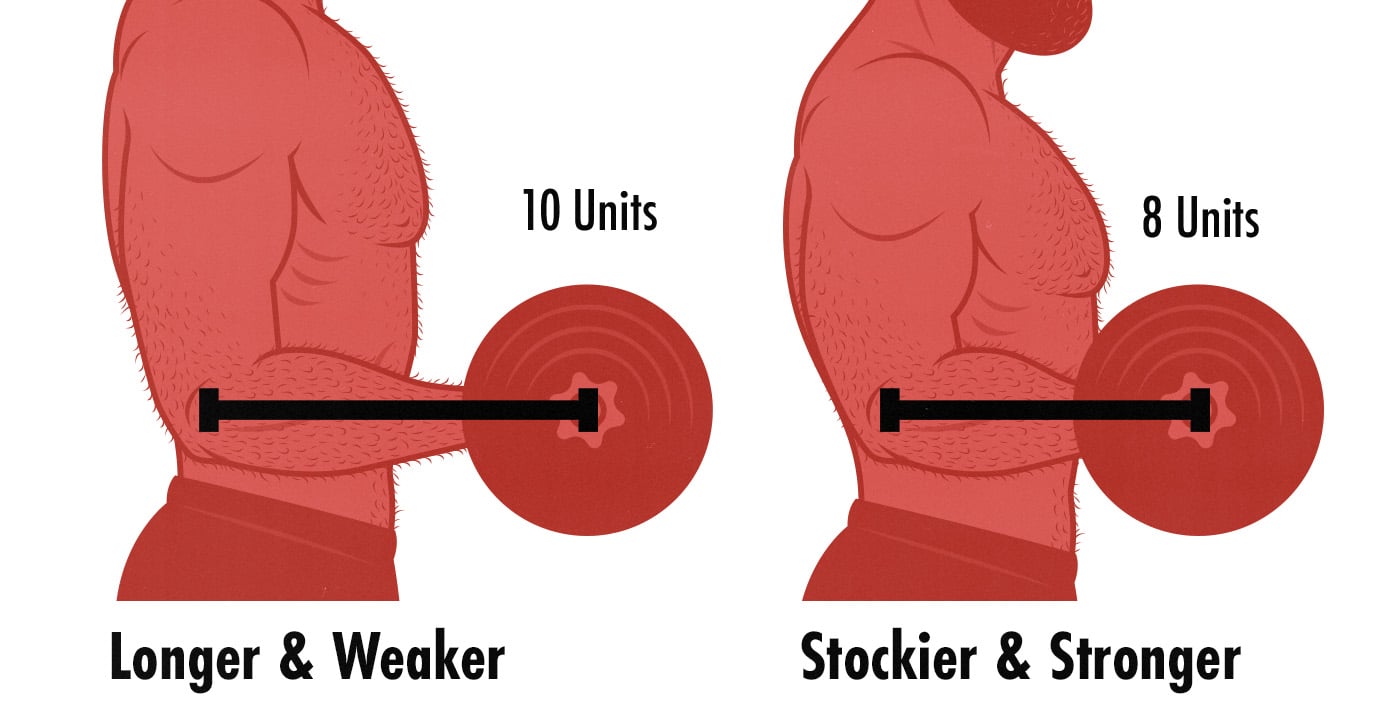
The longer your limbs are, the longer your moment arms are, giving you worse leverage when lifting weights. For example, if your forearms were 20% shorter, your biceps would have 20% better leverage, and you’d be able to curl 20% more weight.
Unfortunately, most of us skinny guys are on the taller, thinner side. That means our biceps are smaller but need to overcome a longer moment arm. This can make us weaker than we look. We tend to be particularly bad at squats, bench presses, biceps curls, and overhead presses. Those lifts favour people built like crocodiles.
However, different exercises benefit from different body proportions. Someone with short arms would need to bend over much further when deadlifting, putting them at a disadvantage. That’s why a lot of skinny guys can build impressively strong deadlifts. Even better if you have a gorilla build with long arms and a short torso.
Also, some exercises force us to lift our body weight, meaning that the lighter our bodies are, the easier the exercise gets. Thus, skinny guys can often get really good at push-ups, pull-ups, callisthenics, and running. (If you consider someone’s ability to run long distances a form of strength, then you can absolutely be skinny and strong. We’re the best in the world. That’s stretching the definition of strength, though.)
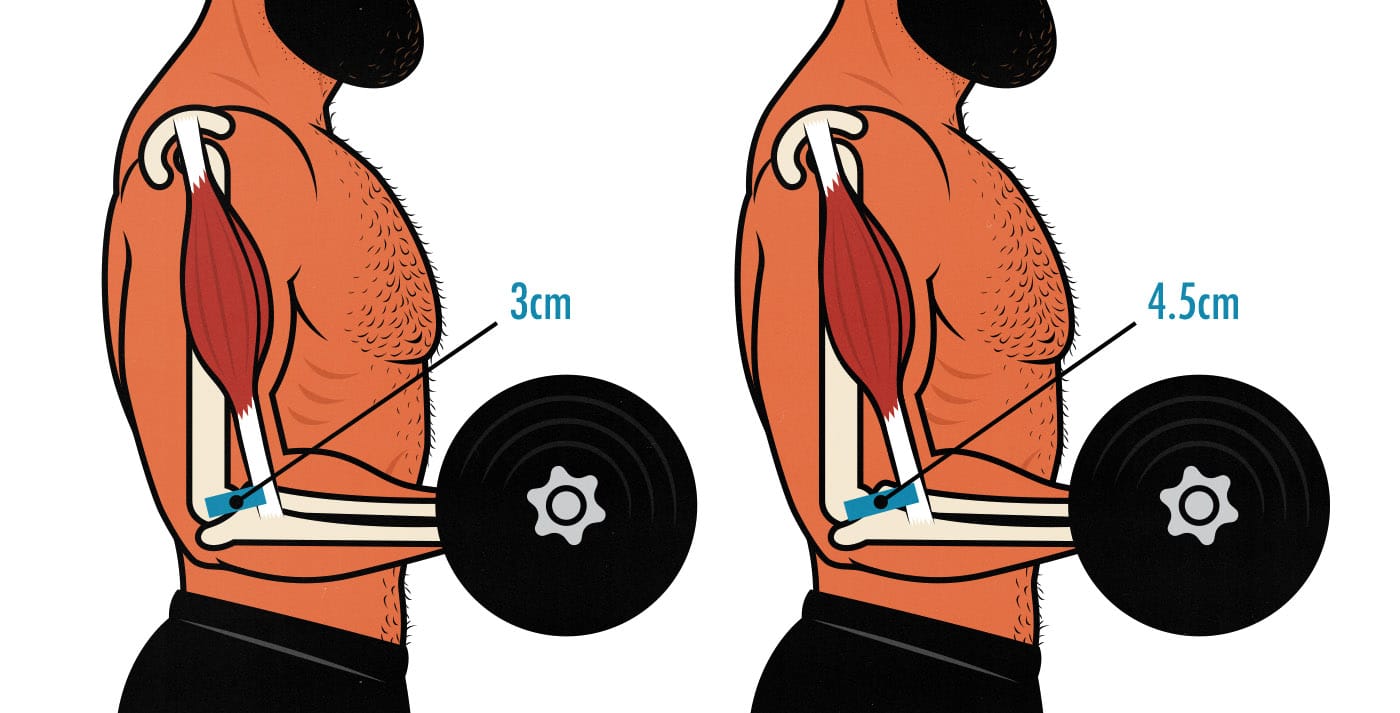
The next thing to consider is muscle insertions. Our muscle insertions affect our leverage in the same way as our limb lengths, in reverse. The further away the insertion is, the more leverage you have. In this case, having biceps that insert 50% further away from your elbows would make you 50% stronger.
So, if you combine good body proportions with good muscle insertions, you can have a skinny guy who can lift twice as much weight with the same amount of muscle. He can be skinny and strong.
Strength Training
Strength training is the style of training designed to make you stronger for your size. It does this in two main ways:
- When you practice an exercise, you get better at it. Your technique improves. You learn to lift with better leverage. This makes you stronger.
- You learn to contract your muscles more forcefully. Your muscles usually prefer to ration their energy so that you can keep lifting things for longer. But if you practice lifting very heavy things, they’ll learn to contract more fully, saving less strength for later. That’s why strength training programs use heavy weights for fewer reps (usually 1–5 reps per set). This doesn’t make you stronger, per se, but it definitely makes you better at powerlifting.
Strength training also challenges your muscles, stimulating growth, which can make your muscles bigger and stronger. However, it takes extra energy to build bigger muscles. Overweight and skinny fat people can get that extra energy from their body fat, “recomping” their fat into muscle, but skinny guys don’t have enough extra body fat to convert into muscle, so they can’t. They need to get their extra energy from their diets. This is called “bulking.”
So, a skinny guy can follow a strength training program, get stronger, not gain weight, and not build muscle. He can get stronger while still being skinny. Mind you, he’d get even stronger if he ate enough food to gain weight.
Are Bigger Muscles Always Stronger Muscles?
The bigger a muscle is, the stronger it is. That really is true, but it’s also surprisingly controversial. There are two different counterarguments you’ll hear:
- Bodybuilders aren’t always strong at everything. Some people think bodybuilders are big but weak, whereas powerlifters, callisthenics athletes, or (insert favourite strength sport) are small but strong.
- Some studies show muscle gains without strength gains. Some researchers use this to argue that building bigger muscles won’t make you stronger. Jeremy Loenneke, the famous Blood Flow Restriction researcher, made this argument on the Peter Attia podcast.
Both of these observations are true, but only in very limited circumstances. A bigger muscle has a greater potential for strength, but that doesn’t always mean that people with bigger muscles can lift more weight or do more things. Here’s why:
- The big muscles might be the wrong muscles. Deadlifts require hip, leg, postural, and grip strength. If a bodybuilder is missing any of those things, he won’t be able to deadlift much weight. That’s how you can get a bodybuilder with big arms, broad shoulders, and a wide chest who isn’t very good at deadlifting, squatting, doing chin-ups, carrying a fridge up the stairs, or turning a wrench. He’s probably great at biceps curls and bench presses, though.
- They might have practiced the wrong thing. If someone hasn’t ever practiced squatting before, they won’t be very coordinated, and they won’t be able to lift much weight. If they haven’t ever practiced squatting for heavy sets of 1–5 reps, they won’t know how to fully contract their quads and glutes. They might be big and strong, just not in the specialized way that’s being tested. That’s why some muscle-building studies show muscle growth without showing strength gains.
So, if someone builds big muscles by squatting, benching, and deadlifting in lower rep ranges, you can rest assured they’ll have impressive squats, bench presses, and deadlifts. However, if they build big muscles by doing push-ups, pull-ups, and pistol squats, they might not. And vice versa.
Mind you, if you build big muscles by doing one thing (e.g. push-ups) and decide to transfer that strength to another exercise that uses the same muscles (e.g. bench presses), then all you need to do is develop coordination. That’s pretty easy. Bodybuilders who start powerlifting tend to get very good very quickly.
The Skinny & Strong Build
If you want to be both skinny and strong, you can do it—sort of. You could bulk up the muscles you care about while keeping the others thin. You’ll also need to train those muscles to do exactly what you want them to do.
For example, let’s say a skinny guy wanted to excel at powerlifting while staying fairly light. He could focus on squats, bench presses, and deadlifts, bulking up his thighs, glutes, chest, and postural muscles. The lateral and medial heads of his triceps would get bigger, too. So would the fronts of his shoulders. But he’d still have relatively thin calves and arms. His neck and jaw would still be thin. His shoulders and back wouldn’t be that wide. He could still have a thin look to him.
However, only bulking up some of your muscles means that you’ll be stronger at fewer things. You don’t need a thick neck for powerlifting, but you do need one for contact sports, taking a punch, and racing at high speeds. You don’t need biceps for powerlifting, either, but you wouldn’t be able to carry much weight in front of your body without them.
The more specialized your strength, the narrower it is. If you want to be strong overall, it helps to get bigger overall.
The Best Way for a Skinny Guy to Get Stronger
It’s hard to tell how strong someone is just by looking at them. Bigger muscles are stronger muscles, but that doesn’t tell you about their leverage and coordination, and they might have a weak spot, like a bad back.
Still, if all else is equal, the bigger someone’s muscles are, the stronger they are. So, if you’re skinny, the best way to get stronger is to build bigger muscles (full explanation). Just remember to train for the type of strength you care about. That way, you develop the right muscles and coordination.
If you want to be generally strong, I recommend building muscle by doing:
- Squat variations like goblet squats, front squats, back squats, and split squats.
- Pressing variations like push-ups, bench presses, dips, and overhead presses.
- Deadlifts and other hip hinges like Romanian deadlifts, trap bar deadlifts, and step-ups.
- Pulling exercises like pull-ups, chin-ups, pulldowns, and rows.

These big compound exercises are great at training the prime movers along with the supporting muscles and postural muscles. For example, front squats train your quads just as well as leg extensions, but they also train your glutes, core, and spinal erectors, giving you even more muscle and strength.
You can expand that list as much as you want. If you want stronger abs, add in planks and hanging leg raises. For a stronger grip, add in farmer carries. To get a stronger neck, add in neck curls.
You can add more isolation exercises, too. In fact, you probably should. Think about the strength you’d need to carry something in front of you, in your arms. That specific type of strength isn’t trained very well by compound exercises. Biceps curls are much better.
Then, you need to get stronger at those exercises. This is called progressive overload. You don’t need to worry about your 1-rep max, but every time you repeat a workout, add a little bit more weight or fight for some extra reps. If you aren’t making progress, try being more consistent, doing more sets, eating more food, and gaining more weight. Over time, you’ll get bigger, and that extra size will make you stronger.
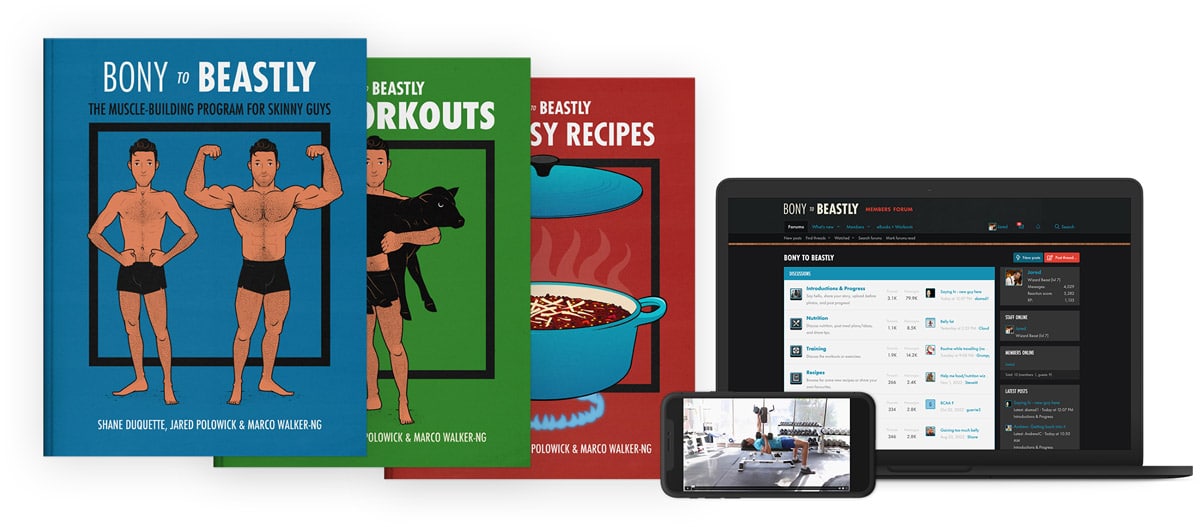
If you want help gaining muscle and strength, we have a free newsletter. If you want a muscle-building program for naturally skinny guys, including a 5-month full-body workout routine, gain-easy diet guide, recipe book, and online coaching, check out our Bony to Beastly Bulking Program. We also have a program for skinny women.
Shane Duquette is the founder of Outlift, Bony to Beastly, and Bony to Bombshell, each with millions of readers. He's a Certified Conditioning Coach (CCC), has gained 70 pounds, and has over a decade of experience helping more than 15,000 people build muscle. He also has a degree in fine arts, but those are inversely correlated with muscle growth.
